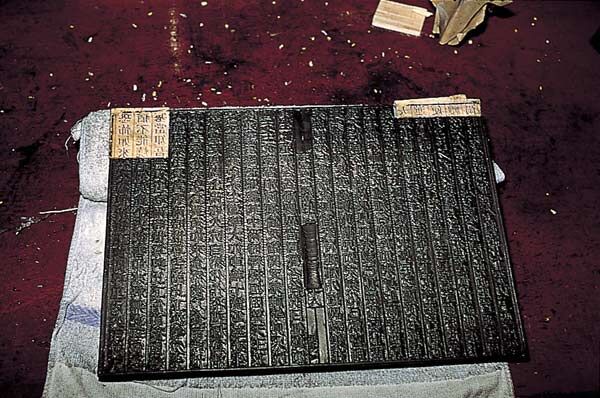The concepts covered in this sheet go beyond those seen in secondary school. It is intended as a supplement for those who are curious to find out more.
The idea of humanism is mainly associated with the perception of humanity during the Renaissance.
This accumulation of radical changes contributed to the name of the Renaissance and also to the negative judgement that the humanists made of the Middle Ages.
For the links below: each of the links on the left concerns one of the facets of humanism. The links in the right-hand column concern important people, concepts or events.
As the Renaissance and humanism were mainly born in Italy, Renaissance art is generally associated with Italian art. Although many artists elsewhere in Europe participated in the renewal of art, they were generally inspired by Italian painters. Italian Renaissance artists were mainly concentrated in the cities of Florence, Rome and Venice.
The Italian Renaissance can be divided into three periods: the Quattrocento , the Classical Maturity and Mannerism.
This period marks the beginning of the Renaissance, and thus the start of the new experiments that distinguish the art of the Middle Ages from that of the Renaissance. The 15th century (the 1400s, hence the Italian name Quattrocento) was the first period during which painting established itself as the predominant artistic genre.
A number of painters contributed to the development of painting through their research into shapes, colours, perspective and proportions. Painters worked on landscapes and portraits that were increasingly representative of nature. One of the artists' aims was to understand nature. Above all, this research enabled them to move away from the two-dimensional works with no perspective or proportions that were produced in the Middle Ages.
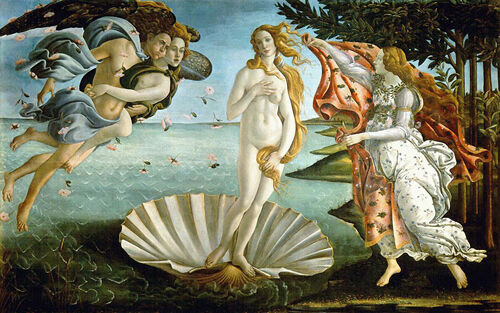
The birth of Venus
Botticelli, even though he was creating at the end of the century, is associated with the Quattrocento through what his works reflect. He painted with the aim of recreating the ideal of ancient art, while adding a touch of invention and suggestiveness. Here: The Birth of Venus , painted around 1485.
This period, also known as the High Renaissance, saw the emergence of the classical painters who still mark artistic culture today: Leonardo da Vinci, Michelangelo, Raphael and others.
The main aim of these painters was to preserve the contributions of the Quattrocento in terms of realism, while greatly reducing the mathematical and rectilinear aspect of their works. This is why most of the works tend to create a balance between lines and colours, space and surface, the real and the ideal, and so on.
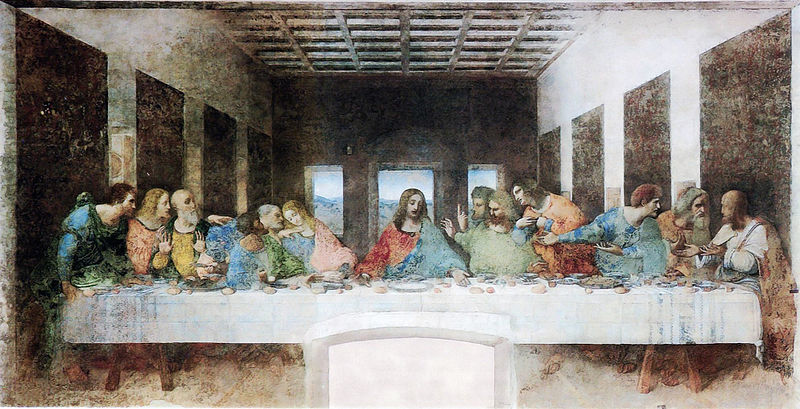
Leonardo da Vinci (1452-1519) - The Last Supper (1495-1498)
This period, from 1520 to 1580, is also known as the Late Renaissance. Essentially, it was a response to the principles of the previous period. Not a break with, but rather a different way of conceiving art, drawing on what had gone before. Works from this period (see Tintoretto's Last Supper below) featured more disjointed spaces, blurred images, distortions of the body, a search for movement - in short, a certain confusion settled in the middle of works that would otherwise have been stable, clear (Leonardo da Vinci's version above).
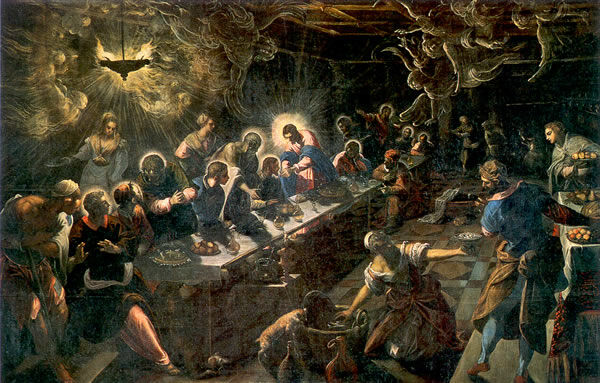
Tintoretto's Last Supper (1594)
A number of Italian painters left their mark on the artistic landscape of the time. Many of them worked for those in power or for members of the clergy. These artists were also multi-talented creators: painters, sculptors and architects.
A number of well-known works come from this period. Raphael, who was a painter and architect, represents all the classical ideals: his forms and compositions are clear, without being too rectilinear. He worked extensively in the service of the Church, for which he created numerous frescoes.
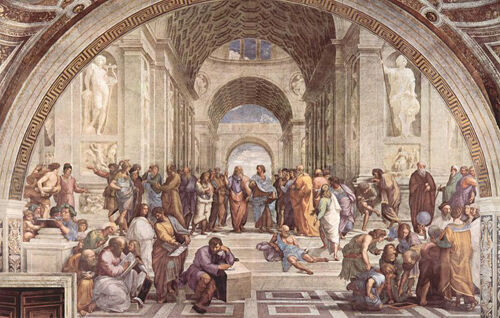
The School of Athens , 1509-1510
Some of his paintings perfectly combine Antiquity's pagan and Judeo-Christian traditions. Raphael was also, for a time, the director of work on the Church of St Peter in Rome.
It was Michelangelo, however, who completed the work by creating the domes above the church. Michelangelo was a sculptor, painter and architect. His works tend to represent the synthetic aspect of his subjects, while giving them a grandiose style. They also express the constant struggle between matter and spirit.

St Peter's Church in Rome
Michelangelo is best remembered for two of his works: the statue of David (sculpted from a block of marble over 4 metres high, which is an astonishingly good representation of the human form) and the ceiling of the Sistine Chapel, where all the frescoes are structured with several systems of perspective and astonishing contrasts of scale.

Statue of David
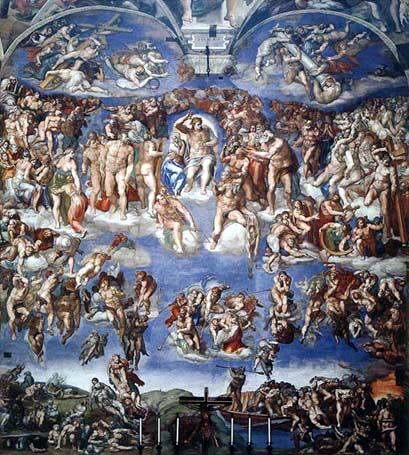
Fresco in the Sistine Chapel
Leonardo da Vinci saw himself as a universal creator: sculptor, architect, town planner, musician, inventor, painter and so on. He painted with a highly sensitive approach that easily stood out from the works of the Quattrocento. He succeeded in reconciling lines and colours, while respecting systems of perspective down to the smallest detail.
The technique he used is known as sfumato. This technique aims to eliminate the contour lines that delimit the shapes. In Da Vinci's works, this delineation is achieved through fluid transitions between colour tones and between areas of light and shadow. His best-known painting is undoubtedly the Mona Lisa, painted using the sfumato technique.
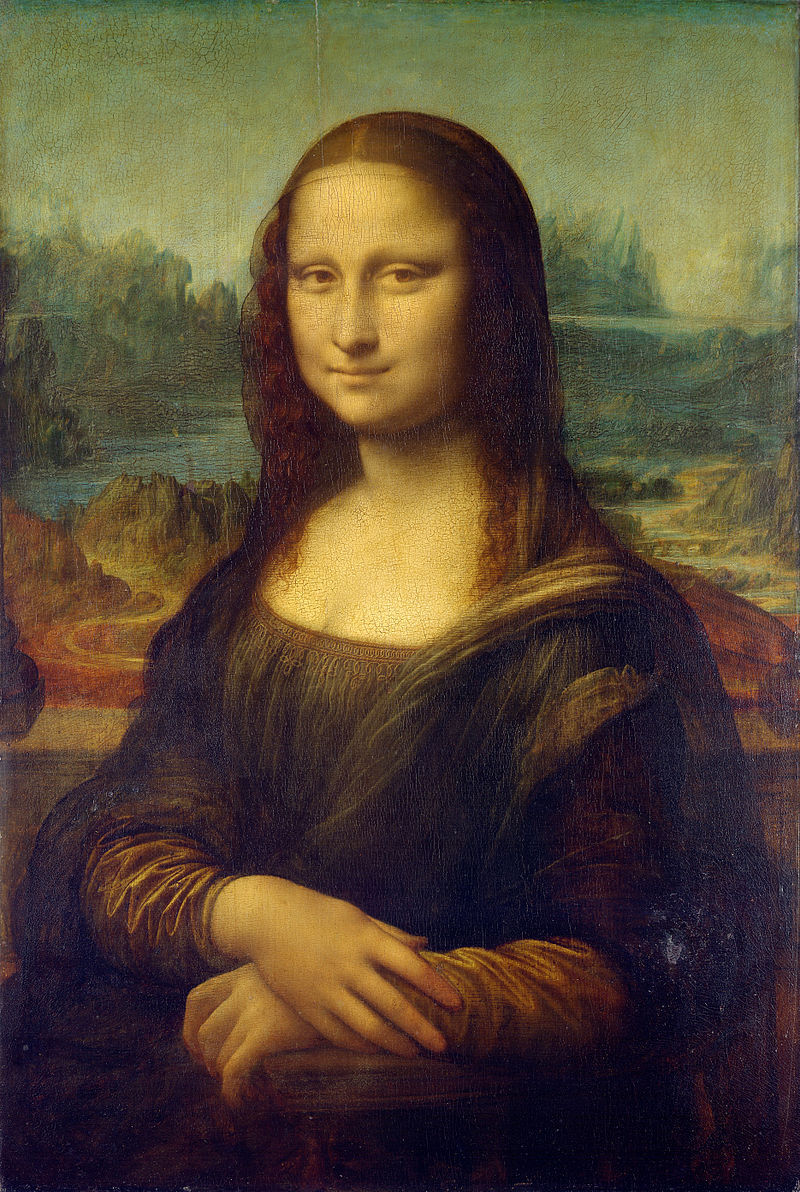
The Mona Lisa
Music is the art form that took the longest to evolve. Indeed, changes in the Papal edict on composition, forms and instruments did not take place until the 16th century. Musical culture was also revitalised by the influence of Greco-Roman content. The instruments used changed and the most popular became the lute, often accompanied by the harp and flute. Renaissance music bridged the gap between medieval and Baroque music.
One of the musicians who best represents the music of the period is Monteverdi. After receiving humanist training, this musician and composer composed madrigals (a form of song) in which the main function of the musical instruments was to accompany the voice. Monteverdi also composed several lyric dramas that offered a completely new way of telling stories in song. Lyric drama is considered to be one of the earliest forms of opera.
The architectural style of the Renaissance was no exception to the other arts of the time, and was also inspired by Antiquity. The new architecture was based on abstract aesthetic principles such as symmetry and proportion. Architects completely abandoned the Gothic style of the Middle Ages, which was considered monstrous, barbaric, confused and disorderly. To develop the new principles, the architects studied the Antiquity monuments of Rome. These new principles were
- The regular plan: the façade had to be straight and right angles were favoured;
- Equality of bays and alignment of openings: the openings must be of the same size and regularly spaced, and the bays must be at the same level;
- Symmetry: the two halves of the building must be symmetrical;
- Proportion: all parts must be multiples of a basic module.
The Farnese Palace, designed by Michelangelo, is a perfect example of a rectilinear, regular and symmetrical building.
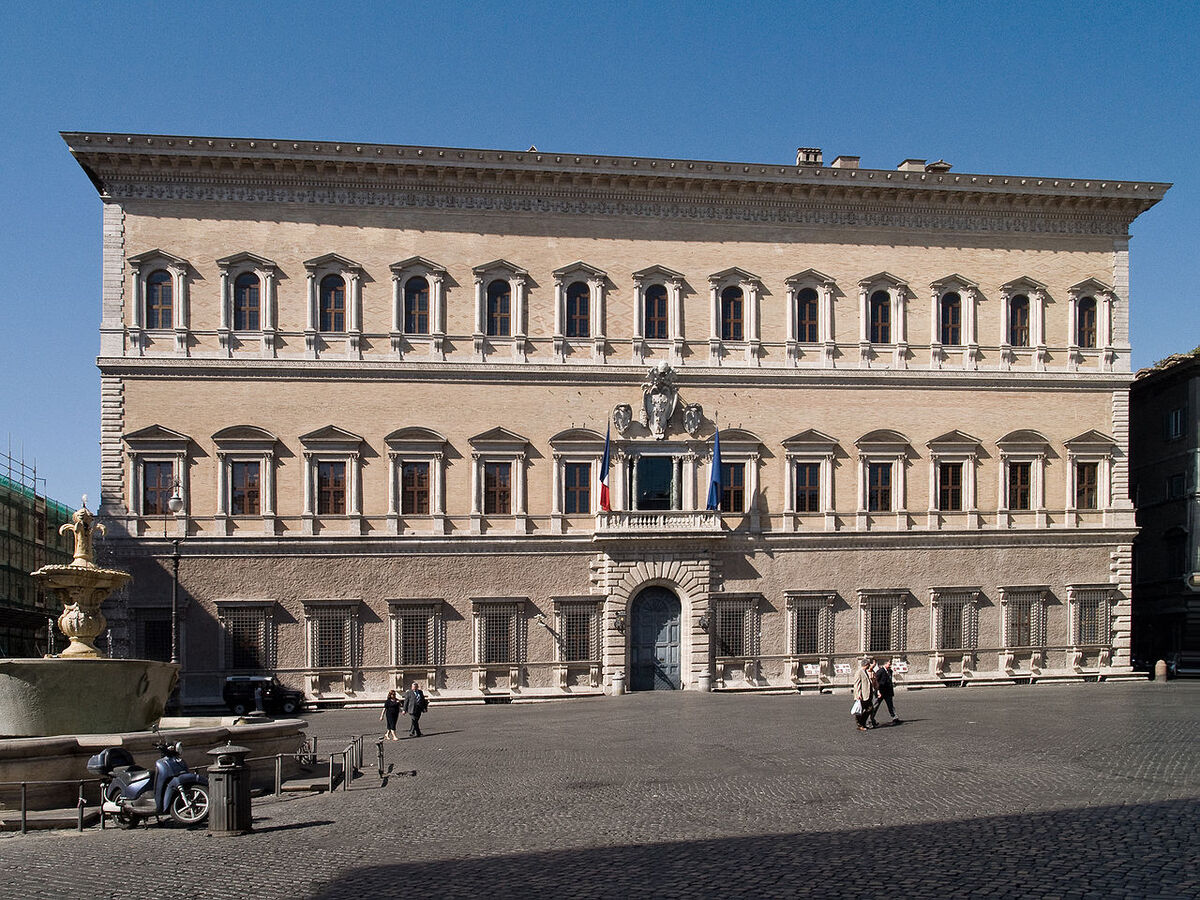
The Farnese Palace
These new principles were expressed in the construction of castles, palaces, churches, villas and public squares. These principles also brought new elements to buildings, such as :
- Columns, which were once again given pride of place, with codes for size and decorative elements.
The Hospital of the Innocents in Florence, designed by Brunelleschi.
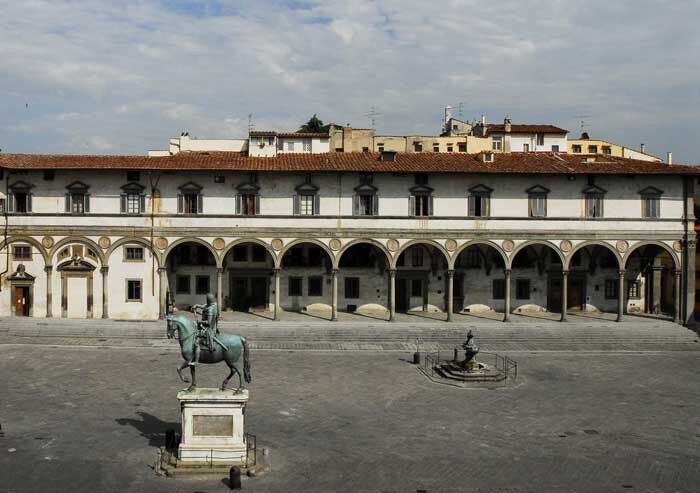
The Innocents Hospital
- The dome, which was a real innovation at the time.
The dome of Florence has become the symbol of the city and an architectural treasure. It too was designed by Brunelleschi.
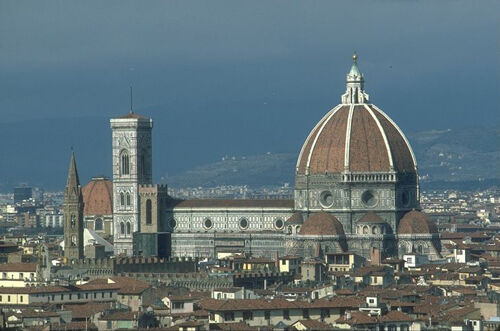
The cupola in Florence
- The ornaments, which must be geometric or naturalistic motifs.
- The drums, domes, lanterns and vaults, all in line with the new principles.
Humanism combines knowledge with the development of society. Sharing knowledge is therefore extremely important in humanist philosophy. This is why the relationship between education and the humanists changed. Humanist education should not only encourage the learning of ancient languages, but should also make it possible to learn the new sciences, the traditions of Antiquity, a good general knowledge, etc.
The adage that best represents humanist philosophy in relation to education is a healthy mind in a healthy body. This is why physical fitness is so important in the training of future scholars. This complex, all-encompassing education enables the formation of a strong mind that will take its destiny into its own hands. Here is a concrete list of the subjects that the young pupil had to learn and master: Greek, Latin, Hebrew, knowledge of ancient texts, mathematics, medicine and anatomy, astrology, drawing, botany, zoology, geography, sports and military arts, study of the Bible, and so on.
The text that best represents this optimistic vision of education is Rabelais' Pantagruel. Pantagruel's father wrote him a letter in which he reminded him of the subjects he needed to master and the importance of education.
During the Renaissance, scientific methods changed and developed considerably. As a result, all disciplines underwent significant improvements. Research methods became more precise, and results more reliable and accurate. A theory of research based primarily on observation was developed. However, this observation was based on rationally and methodically organised experiments. This contributed to the foundation of a more rigorous scientific method, closer to that of modern science.
Mathematics improved and developed greatly thanks to new methods of numerical and algebraic calculation. It was also during this period that trigonometry was developed and logarithms discovered. Some mathematicians also laid the foundations for integral calculus.
Similar progress was made in the natural sciences, with numerous treatises and encyclopaedias appearing on human anatomy, botany and chemistry. A number of inventions were also made possible by the new scientific methods: printing, gunpowder, watches, microscopes, barometers and so on. Astronomy is probably the science that evolved the most during this period. Many scientists carried out research and observations in an attempt to understand the system of planets.
The Church tightly controlled the emergence of new ideas. Many discoveries were judged to be heretical and therefore against the Scriptures. In this situation, the Church rejected the proposed theories and sentenced some scientists and professors to death. The development of science was easier when it respected the dogmas of the Church. However, some areas were less strict than others and allowed scientists to discover the world with complete objectivity.
Ptolemy was not a Renaissance scientist. He was born in Egypt around 90 A.D. He studied astronomy, among other subjects, but devoted himself to the study of several disciplines, including mathematics, optics, geography and so on. He also produced some interesting theorems on geometry, sines and the number pi. In his treatises, he studied the cycles and movements of the sun, moon and other stars. Ptolemy's model, which was to have a lasting impact on science, was undoubtedly his planetary model. This is geocentric, meaning that it places the Earth at the centre of the universe. All the stars and planets would rotate around it in perfectly circular orbits.
His model was similar to Aristotle's, but he added the epicycles, or rotations of the planets around a smaller axis. This theory assumes that certain planets rotate around a circle, which in turn rotates around the orbit. Ptolemy's model is not the only one to have existed to explain the movement of the planets. Long before him, another scientist had already put forward the hypothesis that the Earth revolved around itself and the Sun. This was the system that people adhered to at the beginning of the Renaissance.

Ptolemy's model
Nicolas de Cues (1401-1464) was a German theologian and is considered to be the leading thinker of the Renaissance. In his most influential work, La docte ignorance, de Cues explains how and why man is unable to reach the truth. Truth is elusive and indivisible. Another section of his text focuses on astronomy. In this section, de Cues challenged Ptolemy's model and put forward the hypothesis of the Earth's movement. This challenge was the first to pave the way for future astronomers.
Copernicus (1473-1543) was the first astronomer to truly propose a heliocentric astronomical model. This model was radically opposed to that of Ptolemy, since it placed the Sun at the centre of the universe. The planets would then be arranged around the Sun, according to the time of rotation. His theory explains the apparent movement of the planets, demonstrates that the Moon is a satellite of the Earth and that the Earth's axis of rotation is not fixed.
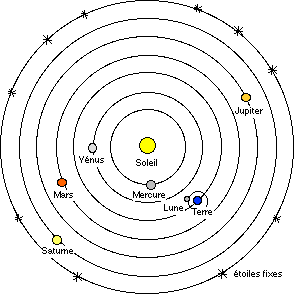
Copernicus model
However, Copernicus did not publish his theories until shortly before his death. He feared the reactions of the Church. In his book, to avoid the negative judgement of the Church, he also presented his theories as hypotheses. However, the Church prevented anyone from teaching Copernicus' model. In fact, more than a century passed before his theories were accepted.
Galileo Galilei (1564-1642), better known as Galileo, carried out many different types of research during his lifetime: studies on the fall of bodies, the principle of relativity of motion, the invention of the astronomical telescope (his second model magnified objects 9 times), and several discoveries about the stars.
It was these numerous discoveries in astronomy that made him so popular. However, because he was a supporter of Copernicus' model, many people condemned Galileo's ideas. As well as confirming Copernicus' ideas, Galileo also discovered 4 satellites of Jupiter and made interesting discoveries about Venus. In addition, Galileo used tidal movements to prove the theory of the Earth's movement around the Sun.
However, theologians continued to regard these ideas as heretical. Copernicus' book was put on the Index, and Galileo was asked to stop mentioning heretical ideas. With the approval of a new Pope, Galileo set about writing a book in which he objectively presented all the planetary systems in existence. The new Pope changed his mind and strongly disapproved of the project. Galileo went on trial and was found guilty of defending Copernicus' ideas despite the ban. Galileo and his ideas were not rehabilitated until 1757.
Johannes Kepler (1571-1630) was an astronomer and teacher who supported Copernicus' system. In fact, he taught it to several classes. His first work dealt with planetary orbits. At the time, he imagined them to be perfectly circular. He suffered some religious persecution, but not as many negative consequences as Copernicus and Galileo. He continued his studies and finally proposed two laws of planetary motion. These laws became known as Kepler's laws. He developed a third law some time later. It is in one of these laws that he now presents orbits as ellipses, one of whose foci is occupied by the Sun. All of Kepler's works constituted the basic material for astronomers for more than a century.
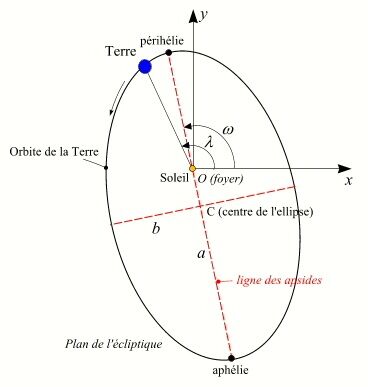
Kepler's diagram of the Earth's orbit
The Reformation of the Catholic Church grew out of a movement of dissent within the Church. It is now regarded as a major upheaval in the history of Christianity. Basically, the Reformation can be defined as a spiritual movement motivated by the search for fidelity to the true biblical message and not to tradition and the papacy.
The ideas of disputation are partly rooted in humanist philosophy, which emphasised the development of a critical mind and the need to form one's own ideas based on the texts read. Based on this principle, certain theologians who studied the Bible noted enormous differences between the holy texts and what was conveyed by the institution. In addition to creating a more developed critical mind, it advocates greater responsibility on the part of man for his own destiny. Humanist philosophy can therefore be seen as a precursor to the Reformation.
It should be added, however, that the printing press also encouraged this movement towards sacred texts. The texts were now more accessible, thanks to lower costs and the availability of translations. A number of theologians also questioned the official translations promoted by the Church.
At the same time, several congregations and churches were struggling to collect donations from parishioners. To solve this problem, in 1516 the Church introduced the system of Indulgences.
Indulgences are in fact certificates of remission of sins issued in exchange for certain sums of money. The biggest donors, the richest, are then forgiven of all their sins thanks to these attestations. The Church makes a lot of money from these indulgences.
An indulgence voucher aimed at all those who regularly visited a church. This way of attracting the faithful would have enabled the church tower to be built.
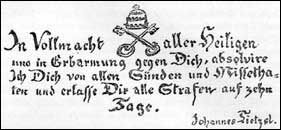
An indulgence voucher
It is interesting to note that these Indulgences are not only for sins already committed, but also for future sins. The system thus becomes an insurance policy against hell for the better-off. These indulgences open the way to strong questions about the links between social class and the forgiveness of sins on the one hand, and the links between money, the possibility of buying sins and morality on the other.
This system created a great deal of dissatisfaction among the population, with many peasants rebelling against certain swindles perpetrated by certain members of the clergy. What's more, these indulgences created a state of anxiety about death: many of the faithful were afraid of the afterlife because they couldn't afford to pay for enough indulgences.
To complete the picture of frustration with the Catholic Church, there was also criticism of the Church's abuses. Many scholars roundly criticised the corruption rampant among the clergy, where monks who had taken a vow of chastity lived in opulence and the Vatican led a rich, opulent and arrogant life. People were also critical of the fact that many members of the clergy were the source of scandal and that many of them had questionable morals. The papacy and its justification were called into question.
Against this backdrop, where many aspects of the religious establishment were being strongly questioned, one theologian succeeded in expressing the frustration that was building up in society. Martin Luther (1483-1546) began by questioning the Church's inability to answer questions adequately. Indeed, at that time the Church answered all questions with phrases such as ‘Trust in your Church’. Moreover, the doctrine of Indulgences had greatly contributed to creating a state where Man feared for his salvation.
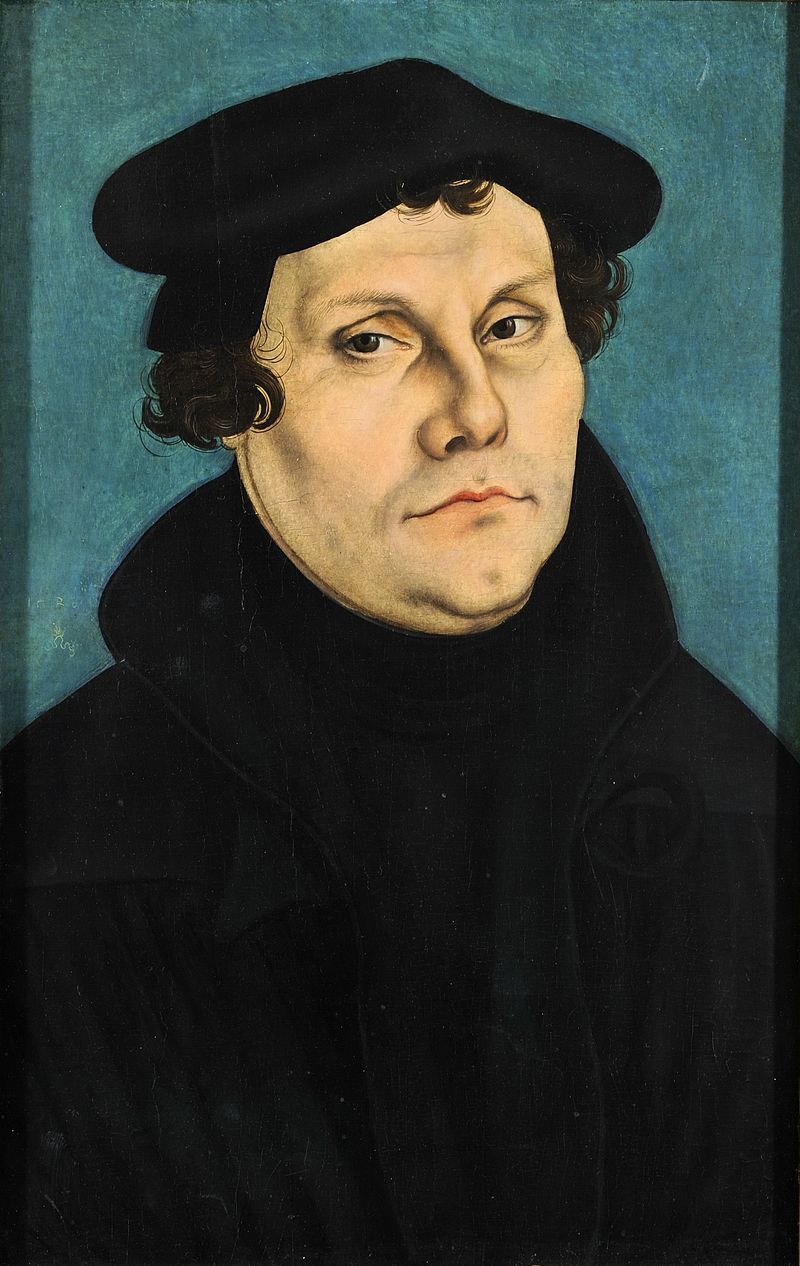
Martin Luther
Luther found himself in a similar situation. It was by studying the Bible for himself that he was able to allay his own fears. He discovered that the texts of the Bible actually affirmed something other than the Church: salvation is in faith and cannot be bought. Given the impact this discovery had on him, Luther began to teach his vision of salvation based solely on faith. He was radically opposed to indulgences. In fact, on the door of a church, he posted a text containing Ninety-five Theses on indulgences.
However, Luther had to flee. During his exile, he set about translating the Bible. He even used the Bible to contradict the Pope, for which he was excommunicated. Throughout his life, Luther continued to write works that developed and supported his doctrine. Luther's ideas spread rapidly, and a number of cities began to break with Catholicism in the years that followed, including Strasbourg and Geneva. Geneva, thanks to Calvin's actions, is considered the spiritual capital of Protestantism.
The Reformers set themselves the task of structuring and organising the new Church around the doctrines inspired by Martin Luther. Calvinist was instrumental in shaping the image of Protestantism. Calvinist's vision was more rigorous.
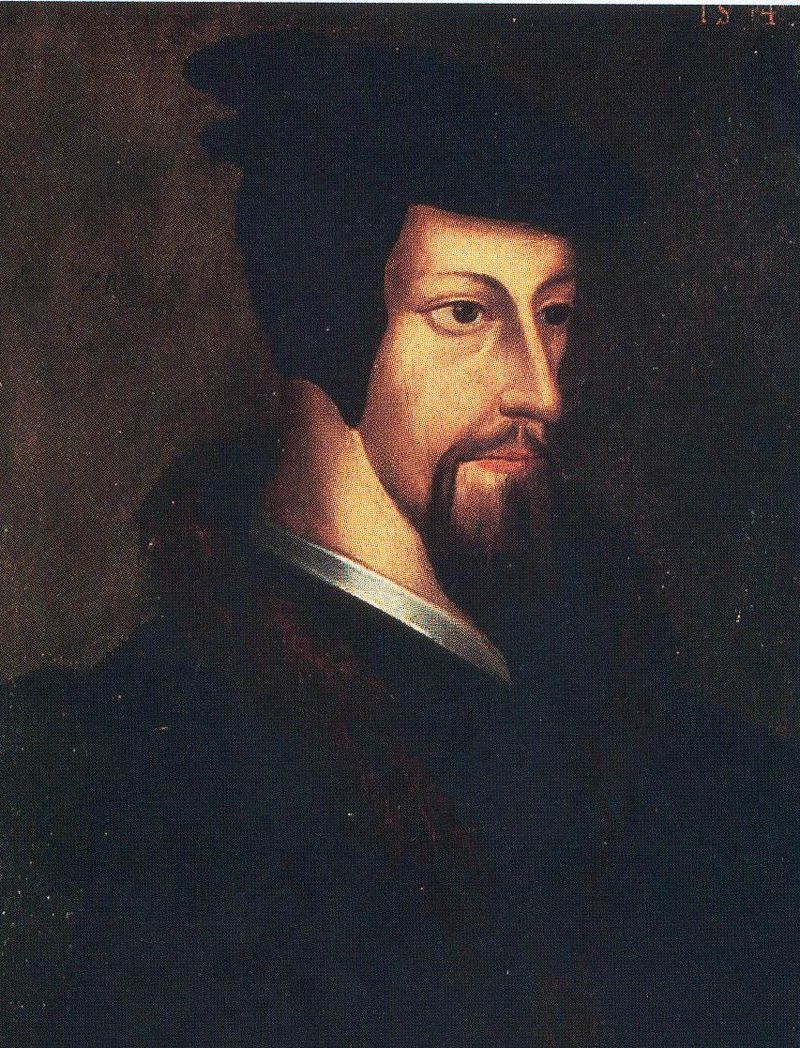
Jean Calvin
Calvin received a humanist education. He quickly embraced the ideas of the Reformation and became a pastor in Geneva. He organised the moral and social life of the city by introducing strict discipline and conservative ideas. In fact, he exiled a number of people who had set themselves up as enemies. In his religious vision, the Church took precedence over the civil authorities.
Unable to hold back these criticisms and new ideas, the Church convened the Council of Trent. This Council was to be the solution to counter the Reformation movement. This reaction by the Church is also known as the Counter-Reformation.
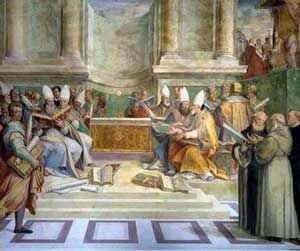
Representation of the Council of Trent
The Council of Trent began in 1545 in the city of Trent, but a number of difficulties hampered its progress: the plague, imperial pressure, Protestant criticism and interruptions. The Council of Trent was concluded in 1563, 18 years after its inauguration, after a 10-year interruption. Despite all these difficulties, the Council of Trent served to renew the papacy's credibility while at the same time calling the episcopal body into question. What's more, the Church wanted to wage war on abuses. A number of important decisions were taken: certain texts were integrated into the Old Testament, the Traditions were considered as complements to the Texts, the 7 important sacraments were fixed, etc.
Since the Reformation, Protestantism has been a part of Christianity and is completely separate from Catholicism. There is no real unity in Protestantism, which is defined more as a collection of national churches, each with its own differences and organisational structure. Protestantism refutes certain aspects of Christianity and considers that Scripture is the only possible religious authority. It is therefore above the authority of the Pope and traditions. It is faith that saves man, and baptism makes all Christians equal before God. Moreover, people have greater autonomy in relation to the Bible: people are invited to read it for themselves. It's a more individual and personalised faith.
Anglicanism is one form of Protestantism. Anglicanism is more temperate than Protestantism. It is found mainly in England, Canada, the United States and Australia. Anglicanism is distinguished by its two sacraments, and ecclesiastical celibacy is not compulsory for Anglicans.
The philosophy of the Renaissance has two facets: the distinction with the ancient being and the development of a new existence. Man entered the era of knowledge of nature and human life. Philosophy was no longer confined within the confines of the Church. Thought centred on Man, who was no longer seen as a sinner, but as infinitely great. Philosophers also tried to combine Antiquity and Christianity, but the emphasis remained on the individual.
Humanism and the scientific method had a strong influence on Renaissance philosophy. Inventions removed the Church's monopoly on knowledge and man developed a new, more personal relationship with God. He had to find salvation in his own piety. Several philosophers left their mark on the period: Montaigne, Descartes and Pascal.
Montaigne (1537-1592) did not define himself as a philosopher, but as an analyst. His object of study was himself. When he wrote his Essays, he wanted above all to discover himself. His philosophy was built around self-knowledge. The wise man is the one who governs himself.
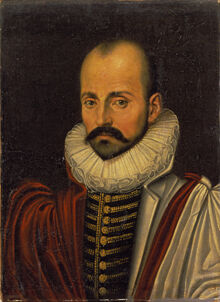
Michel de Montaigne
Montaigne placed his trust in humanity. He used the comparative method to study the differences in individual characters, conceptions, tendencies and nuances. For him, nature contains a profusion of phenomena that call for different personalities. Montaigne highlighted the fact that there was still much to learn. Montaigne's writings are strongly marked by scepticism: doubt in the face of ideas and knowledge. Montaigne is in favour of freedom of conscience, justice and respect for mankind.
Descartes (1596-1650) was a philosopher who worked extensively on mathematics. He built a philosophy around freedom of thought. In his view, misconceptions and ignorance were obstacles to the progress of knowledge, technology and morality. The essence of his philosophy is set out in Le Discours de la méthode. In all of Descartes' areas of study, he always used the same method: doubt as a means of reaching the truth. The object of study for philosophical knowledge is ideas, because it is in ideas that the mind knows things.
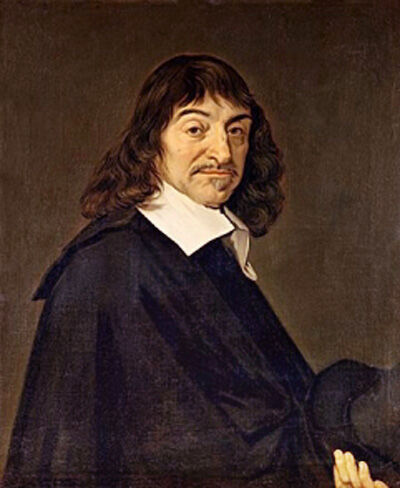
René Descartes
The goal of philosophy and science is the attainment of universal truth. This conquest of truth is, according to Descartes, the most worthy occupation of Man. For Descartes, it is a question of giving the same reason and the same truth to philosophy as to mathematics. Descartes' thinking is therefore based on reason: we must judge and distinguish what is true, and this is done through deduction and intuition. Descartes' theories are based on 4 precepts: methodical doubt (not taking something as the truth without questioning), examining every aspect of a problem, studying everything so as not to omit anything, and constructing knowledge from the simplest to the most complex. It was Descartes who said: ‘I think, therefore I am’, in which he asserted that humanity is distinguished by a thinking self.
Blaise Pascal (1623-1662) was a French scientist who left his mark on the history of science through his rigorous analysis and sense of experimentation. He worked extensively in mathematics and science. Throughout his research, and especially towards the end of his life, he developed reflections on religion and philosophy. The essence of his views is expressed in Les Pensées. Pascal was also in search of truth, but this truth was to be found in spirituality. The worst enemy of faith, according to him, is religious indifference.
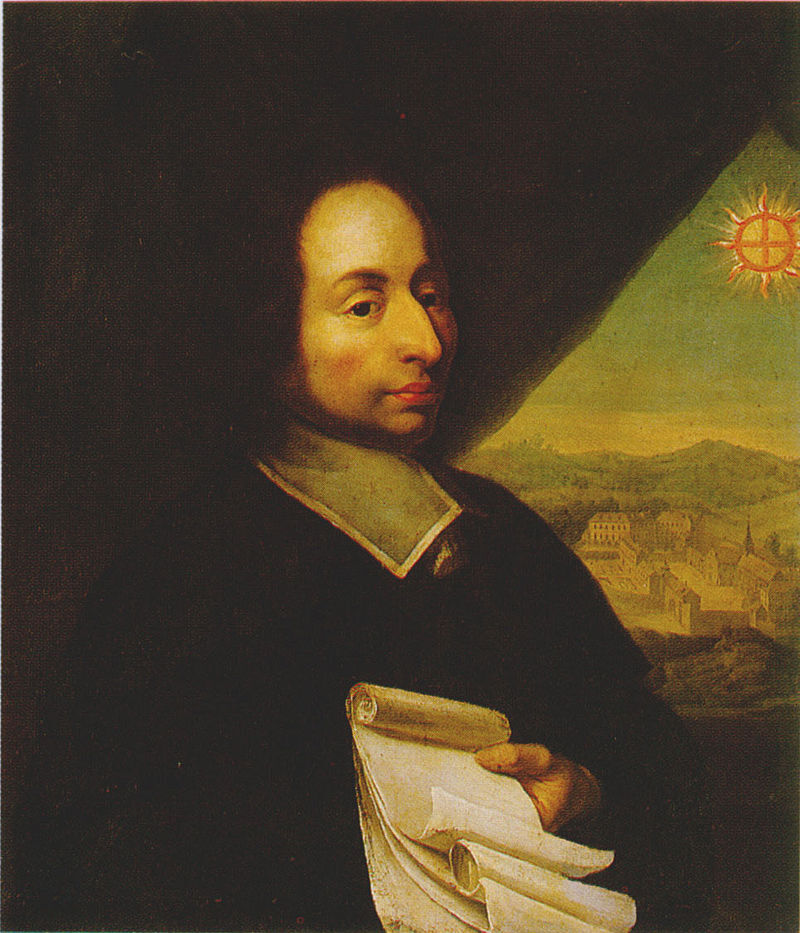
Blaise Pascal
Man, obliged to worry about his salvation, now lives in a state of discomfort in which it is impossible to prove the existence of God, but equally impossible to prove his non-existence. Pascal's aim in writing his Pensées was to show man the limits of his reason, so that he would turn to God. Thought is effectively incapable of accounting for the complexity of the world. Turning to God would be the only way to escape illusion and despair.
Printing is a set of techniques used to reproduce texts and illustrations in large quantities. This process allows texts to be distributed on a large scale. Long before printing, a number of tools existed to perpetuate and disseminate works of art. Scribes and copyists spent their days reproducing works by hand. The process was costly and, above all, time-consuming. That's why they tried to automate copying. Several methods preceded the development of printing: xylography and lithography.
Xylography was a process used in China from the 12th century. It involved the use of engraved pieces of wood. Lithography was based on the same principle, with the difference that engraved pieces of stone were used. The problem with these two methods was that you had to start all over again if you made a mistake.
The printing system that revolutionized text production was developed by Gutenberg. Unlike the two previous processes, Gutenberg's method used a fast and flexible instrument. The printing press used movable metal type. These were placed in wooden frames to form the words and lines. They were also reusable and interchangeable. This meant that the same page could be printed indefinitely in a very short space of time.
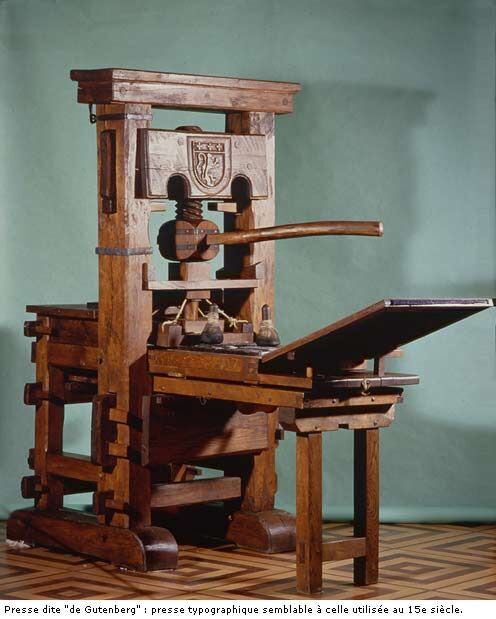
A model similar to the Gutenberg press
Reading became a cheap activity, and books were produced in greater numbers and at lower cost. Several printing centres were set up in European cities and universities. In 1455, there were 2 printing centres, while in 1500 there were 236. Between 1450 and 1500, 30,000 titles were printed in multiple copies, most of them religious works. Many editions were also inspired by humanist ideas: ancient texts were published in their original language and in translation, as well as manuals, grammars and scientific treatises. The very first printed book, however, was the Bible.
Printing thus created a new economy. However, distribution networks did not yet exist. Printers and readers came together at trade fairs or fairs. Books, now accessible, served as a medium for new ideas, which spread more quickly. Printing was one of the first examples to demonstrate the benefits of mechanising manual work.
